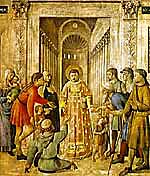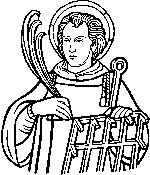Readings:
Daniel 3:19-27PRAYER (traditional language)
Psalm 126
2 Corinthians 9:6-10
Luke 14:12-14
Preface of a Saint (3)
[Common of a Martyr]
[For Social Service]
[Of the Holy Cross]
Almighty God, by whose grace and power thy servant Laurence didst triumph over suffering and didst despise death: Grant that we may be steadfast in service to the poor and outcast, and may share with him in the joys of thine everlasting kingdom; through Jesus Christ our Lord, who liveth and reigneth with thee and the Holy Spirit, one God, for ever and ever. Amen.
PRAYER (contemporary language)
Almighty God, by whose grace and power your servant Laurence triumphed over suffering and despised death: Grant that we may be steadfast in service to the poor and outcast, and may share with him in the joys of your everlasting kingdom; through Jesus Christ our Lord, who lives and reigns with you and the Holy Spirit, one God, for ever and ever. Amen.
Lessons revised at General Convention 2024.
Return to Lectionary Home Page
Webmaster: Charles Wohlers
Last updated: 10 July 2024
LAURENCE OF ROME
DEACON AND MARTYR (10 AUGUST 258)
 Laurence
(or Lawrence) was chief of the seven deacons of the congregation at Rome,
the seven men who, like Stephen and his companions (Acts 6:1-6), were in
charge of administering the church budget, particularly with regard to the
care of the poor. In 257, the emperor Valerian began a persecution aimed
chiefly at the clergy and the laity of the upper classes. All Church property
was confiscated and meetings of Christians were forbidden. The bishop of
Rome, Sixtus II, and most of his clergy were executed on 7 August 258, and
Laurence on the 10th. This much from the near-contemporary records of the
Church. The accounts recorded about a century later by Ambrose (see 7 Dec)
and the poet Prudentius say that, as Sixtus was being led to his death,
Laurence followed him, saying, "Will you go to heaven and leave me behind?"
and that the bishop replied, "Be comforted, you will follow me in three
days." They go on to say that the Roman prefect, knowing that Laurence was
the principal financial officer, promised to set him free if he would surrender
the wealth of the Church. Laurence agreed, but said that it would take him
three days to gather it. During those three days, he placed all the money
at his disposal in the hands of trustworthy stewards, and then assembled
the sick, the aged, and the poor, the widows and orphans of the congregation,
presented them to the prefect, and said, "These are the treasures of the
Church." The enraged prefect ordered him to be roasted alive on a gridiron.
Laurence bore the torture with great calmness, saying to his executioners
at one time, "You may turn me over; I am done on this side." The spectacle
of his courage made a great impression on the people of Rome, and made many
converts, while greatly reducing among pagans the belief that Christianity
was a socially undesirable movement that should be stamped out.
Laurence
(or Lawrence) was chief of the seven deacons of the congregation at Rome,
the seven men who, like Stephen and his companions (Acts 6:1-6), were in
charge of administering the church budget, particularly with regard to the
care of the poor. In 257, the emperor Valerian began a persecution aimed
chiefly at the clergy and the laity of the upper classes. All Church property
was confiscated and meetings of Christians were forbidden. The bishop of
Rome, Sixtus II, and most of his clergy were executed on 7 August 258, and
Laurence on the 10th. This much from the near-contemporary records of the
Church. The accounts recorded about a century later by Ambrose (see 7 Dec)
and the poet Prudentius say that, as Sixtus was being led to his death,
Laurence followed him, saying, "Will you go to heaven and leave me behind?"
and that the bishop replied, "Be comforted, you will follow me in three
days." They go on to say that the Roman prefect, knowing that Laurence was
the principal financial officer, promised to set him free if he would surrender
the wealth of the Church. Laurence agreed, but said that it would take him
three days to gather it. During those three days, he placed all the money
at his disposal in the hands of trustworthy stewards, and then assembled
the sick, the aged, and the poor, the widows and orphans of the congregation,
presented them to the prefect, and said, "These are the treasures of the
Church." The enraged prefect ordered him to be roasted alive on a gridiron.
Laurence bore the torture with great calmness, saying to his executioners
at one time, "You may turn me over; I am done on this side." The spectacle
of his courage made a great impression on the people of Rome, and made many
converts, while greatly reducing among pagans the belief that Christianity
was a socially undesirable movement that should be stamped out. The details of these later accounts have been disputed, on the grounds that a Roman citizen would have been beheaded. However, it is not certain that Laurence was a citizen, or that the prefect could be counted on to observe the law if he were. More serious objections are these:
(1) The detailed accounts of the martyrdom of Laurence confuse the persecution
under Decius with the persecution under Valerian, describing the latter,
not as an emperor, but as the prefect of Rome under the emperor Decius.
(2) We have early testimony that Bishop Sixtus and his deacons were not
led away to execution, but were summarily beheaded on the scene of their
arrest.
 For
these reasons, the Bollandist Pere Delahaye and others believe that Laurence
was simply beheaded in 258 with his bishop and fellow deacons. On this
theory, it remains unexplained how he became so prominent and acquired
so elaborate an account of his martyrdom. Lawrence's emblem in art is
(naturally) a gridiron.
For
these reasons, the Bollandist Pere Delahaye and others believe that Laurence
was simply beheaded in 258 with his bishop and fellow deacons. On this
theory, it remains unexplained how he became so prominent and acquired
so elaborate an account of his martyrdom. Lawrence's emblem in art is
(naturally) a gridiron.